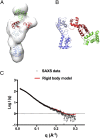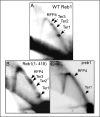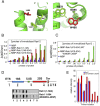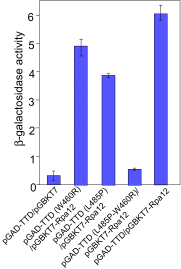Functional architecture of the Reb1-Ter complex of Schizosaccharomyces pombe
- PMID: 27035982
- PMCID: PMC4843429
- DOI: 10.1073/pnas.1525465113
Functional architecture of the Reb1-Ter complex of Schizosaccharomyces pombe
Abstract
Reb1 ofSchizosaccharomyces pomberepresents a family of multifunctional proteins that bind to specific terminator sites (Ter) and cause polar termination of transcription catalyzed by RNA polymerase I (pol I) and arrest of replication forks approaching the Ter sites from the opposite direction. However, it remains to be investigated whether the same mechanism causes arrest of both DNA transactions. Here, we present the structure of Reb1 as a complex with a Ter site at a resolution of 2.7 Å. Structure-guided molecular genetic analyses revealed that it has distinct and well-defined DNA binding and transcription termination (TTD) domains. The region of the protein involved in replication termination is distinct from the TTD. Mechanistically, the data support the conclusion that transcription termination is not caused by just high affinity Reb1-Ter protein-DNA interactions. Rather, protein-protein interactions between the TTD with the Rpa12 subunit of RNA pol I seem to be an integral part of the mechanism. This conclusion is further supported by the observation that double mutations in TTD that abolished its interaction with Rpa12 also greatly reduced transcription termination thereby revealing a conduit for functional communications between RNA pol I and the terminator protein.
Keywords: RNA polymerase I; crystal structure; protein–DNA interaction; replication termination; transcription termination.
Conflict of interest statement
The authors declare no conflict of interest.
Figures












Similar articles
-
Crystallization and preliminary X-ray characterization of the eukaryotic replication terminator Reb1-Ter DNA complex.Acta Crystallogr F Struct Biol Commun. 2015 Apr;71(Pt 4):414-8. doi: 10.1107/S2053230X15004112. Epub 2015 Mar 20. Acta Crystallogr F Struct Biol Commun. 2015. PMID: 25849502 Free PMC article.
-
Mechanistic insights into replication termination as revealed by investigations of the Reb1-Ter3 complex of Schizosaccharomyces pombe.Mol Cell Biol. 2008 Nov;28(22):6844-57. doi: 10.1128/MCB.01235-08. Epub 2008 Sep 15. Mol Cell Biol. 2008. PMID: 18794373 Free PMC article.
-
Regulation of replication termination by Reb1 protein-mediated action at a distance.Cell. 2010 Sep 17;142(6):868-78. doi: 10.1016/j.cell.2010.08.013. Cell. 2010. PMID: 20850009 Free PMC article.
-
Replication termination in Escherichia coli: structure and antihelicase activity of the Tus-Ter complex.Microbiol Mol Biol Rev. 2005 Sep;69(3):501-26. doi: 10.1128/MMBR.69.3.501-526.2005. Microbiol Mol Biol Rev. 2005. PMID: 16148308 Free PMC article. Review.
-
RTS1-an eukaryotic terminator of replication.Int J Biochem Cell Biol. 2002 Sep;34(9):1031-4. doi: 10.1016/s1357-2725(02)00040-7. Int J Biochem Cell Biol. 2002. PMID: 12009298 Review.
Cited by
-
A distinct class of eukaryotic MT-A70 methyltransferases maintain symmetric DNA N6-adenine methylation at the ApT dinucleotides as an epigenetic mark associated with transcription.Nucleic Acids Res. 2019 Dec 16;47(22):11771-11789. doi: 10.1093/nar/gkz1053. Nucleic Acids Res. 2019. PMID: 31722409 Free PMC article.
-
Coupling Between Production of Ribosomal RNA and Maturation: Just at the Beginning.Front Mol Biosci. 2021 Oct 26;8:778778. doi: 10.3389/fmolb.2021.778778. eCollection 2021. Front Mol Biosci. 2021. PMID: 34765647 Free PMC article. Review.
-
Mechanisms of DNA replication termination.Nat Rev Mol Cell Biol. 2017 Aug;18(8):507-516. doi: 10.1038/nrm.2017.42. Epub 2017 May 24. Nat Rev Mol Cell Biol. 2017. PMID: 28537574 Free PMC article. Review.
-
Structural insights into nuclear transcription by eukaryotic DNA-dependent RNA polymerases.Nat Rev Mol Cell Biol. 2022 Sep;23(9):603-622. doi: 10.1038/s41580-022-00476-9. Epub 2022 May 3. Nat Rev Mol Cell Biol. 2022. PMID: 35505252 Review.
-
Structural characterization of DNA-binding domain of essential mammalian protein TTF 1.Biosci Rep. 2024 Aug 28;44(8):BSR20240800. doi: 10.1042/BSR20240800. Biosci Rep. 2024. PMID: 39115563 Free PMC article.
References
-
- Sollner-Webb B, Tower J. Transcription of cloned eukaryotic ribosomal RNA genes. Annu Rev Biochem. 1986;55:801–830. - PubMed
-
- Reeder RH. Regulation of RNA polymerase I transcription in yeast and vertebrates. Prog Nucleic Acid Res Mol Biol. 1999;62:293–327. - PubMed
-
- Németh A, et al. RNA polymerase I termination: Where is the end? Biochim Biophys Acta. 2013;1829(3-4):306–317. - PubMed
Publication types
MeSH terms
Substances
Associated data
- Actions
Grants and funding
LinkOut - more resources
Full Text Sources
Other Literature Sources
Molecular Biology Databases
Research Materials

